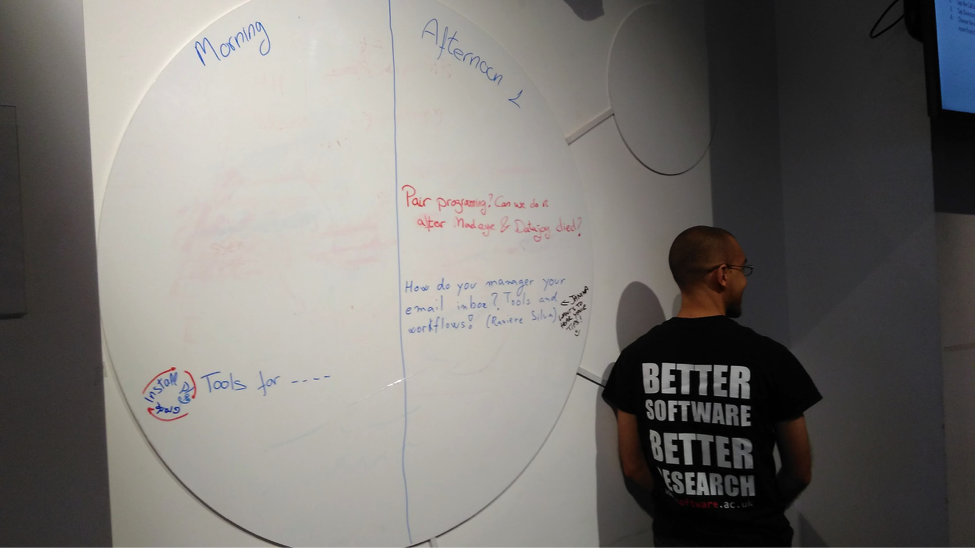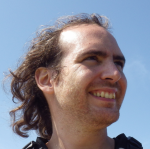A story about Science Together - the unconference about tools and rules in collaborative research
A story about Science Together - the unconference about tools and rules in collaborative research
Posted on 20 April 2017
A story about Science Together - the unconference about tools and rules in collaborative research
 By David Pérez-Suárez, University College London.
By David Pérez-Suárez, University College London.
Originally published at sciencetogether.online.
Why #SciTog
Since I finished my PhD, I’ve worked on various large e-infrastructure projects which aimed to build bridges between various research sub-disciplines within solar system physics. All these projects were doing a great job for researchers in one area to know the effects (or the source) in a different place. That helps a lot to get the bigger picture and to find out interesting events in an easier manner than before. However, I think that’s just the beginning. A researcher specialised in one area may not understand exactly what’s happening in a different one. We were helping researchers to discover data in other domains but not to connect them with the experts in those areas.
Due to my involvement in open source projects and online communities like Software Carpentry, I knew such a thing was possible with the current tools available. But, why were we not using them? That thought embarked me on this adventure, which is not finished, but its first chapter has just concluded.
Getting there...
As part of my Software Sustainability Institute Fellowship, I organised Science Together, an un-conference to discuss the possibilities, the barriers and the tools when working with people that don’t share the same office, or institute, or domain. (What?! Do you think there’s no need because e-mail solves any situation? Don’t get me started!Well, let me tell you…) Yes, I drove the un-conference a bit "against" e-mail. But not because I think it’s evil (yes, I do a little bit) but—as one of the participants said in the survey for booth, the good and bad—everyone uses it, and as such everyone has something to comment about it.
I didn't want the participants of the unconference just being researchers, neither just savvy technological collaborative people. Otherwise, there wasn’t going too much to learn from. So I started inviting key people from different domains: researchers, open source developers, online community members, online artists, collaborative service providers and, more importantly, librarians! Unfortunately not everyone could attend but the group that did was varied enough to spark some knowledge transfer and draw some conclusions about certain topics.
The un-conference
There were 32 registered participants (and only six didn’t show up!!). They were asked at registration few questions like what collaborative tools they use and to say one good and one bad thing about email. With the list of tools I created a cloud with logos (shown in the image) size-weighted by their mentions. Regarding the good vs bad comments received about email, it could be classified as being popular, easy to use, you control its management and it is free as good things whereas the complains grouped into things like they are a source of spam, it’s easy to get unmanageable threads, its misuse (attachments, meaningless subject lines, …) and popularity.

Taking the side of e-mails, we could get similar comments about any tool out there, even more if its uses go beyond what they were created for. To level the field (or as I would say in Spanish, to level the balance) first thing I asked to the participants was to introduce themselves and either say what they love of their least favourite tool or what they hate of their most favourite. Funny enough, most of the people decided to complain about their favourite tool. It was surprising for me to listen that tools like Google Docs were difficult to use for some people and that I’m not the only one to have a personas crisis between work and personal accounts with many different online identities.
I set up different tools to register the evolution of the conference, that included: a channel for chatting connecting IRC, [matrix], Slack and Gitter; a set of etherpads linked to discussion topics and summaries of discussions; a Zotero team to collect papers and blogs; and a group on hypothes.is to record the annotations on websites that we might have done during the two days. The etherpads were the winner of them all! Even when the use of other collaborative editing tools was encouraged. Sadly, I didn’t ask how many people didn’t know about etherpads before; happily I know now that 25 people know about it!
After the introductions, we started with our first keynote: Kim Nilsson, CEO of Pivigo, telling us how to “Set your (data) scientist free!”. Her company provides a service of data scientist teams that work remotely, and she explained how they’ve managed to do so, which tools they use and which rules they follow. In (very) short, they follow these steps:
-
daily online scrum meetings
-
daily Q&A session video call (with a moderator controlling everyone engages)
-
weekly social get-togethers video call where everyone brings a drink (weird at first)
-
let other people know when you’re away
Kim got a few questions afterwards about remote teams working at very different time-zones, to which she replied that in her experience it’s only happened once and the person adapted to the team’s time zone.
The unconference followed up with a session led by my other two important guests, Bianca and Jeroen—the Utrecht University librarians behind 600+ list of tools for scholarly communication. They made us think on how many tools we use and asked us to write them down, then link them if they were integrated with others. They introduced their analysis of workflows between different tools and some other results from their analysis. We then went through an exercise to list and discuss the no-go or attractiveness of any tool we aim to use.
Finally, the last session of the day started as a free will with a speed blogging activity. Where different topics were discussed:
-
Issues and solutions in convincing people to select, adopt, and use certain collaboration tools
-
Legal barriers to collaborative open research - the gap between policies and practice

The second day was complete free-will unconference of three 1.5-hour sessions when for the last ten minutes we reconvened and discussed what had been discussed. All the discussions were recorded in etherpads and are available now at the conference website.

With all that the 2-day unconference finished, probably with the conclusion that we won’t be email free but with a lot of resources and options that we can start to apply in our everyday life to ease our collaborations. And that’s good, because I don’t want Science Together ending here! The resources are available online for everyone and they can be updated by anyone. Let’s hope there will be a #SciTog2!
As a final but not less important note, we got almost a perfect gender equality participation during both days!! That was not easy, but not impossible!

